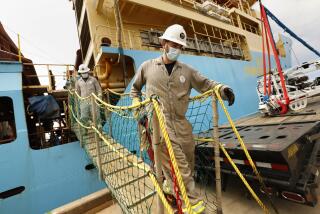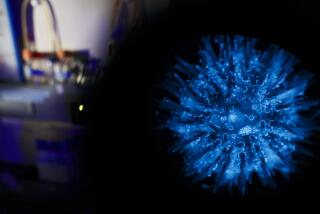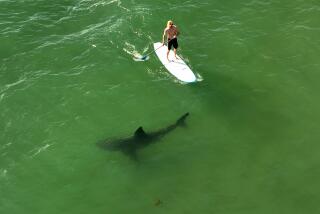Coral Reefs Need a Sea Change in Crime Scene Inquiries
- Share via
ASHLAND, Ore. — When death strikes a coral reef, whether from an oil spill off Mexico or sediment unleashed by a dam bursting in Hawaii, marine biologists at the scene know what to look for, but not how to report and preserve their findings so they will hold up in court.
Not for long.
Biologists and criminalists are joining forces to develop specific crime scene investigation techniques that work underwater, where almost nothing that is standard procedure on land works.
Call it “CSI: Coral Reef.”
“The coral reef is the body,” said Ken Goddard, director of the U.S. Fish and Wildlife Service Forensics Laboratory here, who is supplying the criminal investigation expertise. “Except I can’t take it in for an autopsy.”
They will present their recommendations to the International Tropical Marine Ecosystems Management Symposium Oct. 16-20 in Cozumel, Mexico, and offer a five-day training session afterward for marine biologists from around the world.
The idea was born over drinks last October in Australia among marine biologists attending an international conference on coral reefs, said David Gulko, a coral reef ecologist for the Hawaii Department of Land and Natural Resources.
Gulko has been put in charge of the effort by the International Coral Reef Initiative, an international body dedicated to protecting coral reefs.
“Whether you were in Australia or the States, the Philippines or Indonesia, we were all having the same problem,” Gulko said from Hawaii.
“You have enforcement people charged with enforcing natural resource laws who do not have the proper training or tools to conduct an investigation underwater. Then you have resource managers like myself who have the proper tools and training to conduct an investigation underwater, but no training to do it in a way that will hold up in a court of law.”
Coral reefs, some of the most biologically diverse habitats in the world, are already suffering from warmer ocean temperatures associated with climate change. As much as 40% of coral in waters around the U.S. Virgin Islands died last year.
Although no one has figured out what to do about warm water killing coral reefs, they can do something about oil spills, agricultural runoff, pollution, sediment deposits, ship groundings, garbage dumping and fish poachers, Gulko said.
“We started doodling on a cocktail napkin with various ideas and what came out of that was, ‘Gee, we need the equivalent of CSI for coral reefs,’ ” he said, using the term popularized by the CBS television series “CSI: Crime Scene Investigation.”
But these CSI teams will go beyond catching bad guys, to developing restoration plans for the damaged reefs, Gulko added.
The napkin worked its way up through various agencies. Goddard, a former homicide cop who has headed the world’s only forensics lab dedicated to wildlife since its creation in 1988, was tapped to bring in the criminal investigation expertise.
“We realized that a lot of the approaches a standard homicide cop would use or a CSI team would use to investigate a murder have been translated and are currently being used to investigate wildlife crimes,” said Gulko. “We just needed to translate it to do the work underwater.
“That’s where we hit a wall,” said Gulko. “And the wall was water. A lot of the methods that are sacrosanct for doing CSI on land fell apart underwater.”
Goddard had to take a crash course in scuba diving so he could join Gulko and others late this month on hurricane-damaged reefs off Cozumel, where they will try out the techniques and equipment they are developing, such as modified underwater scooters.
“Almost nothing I know about doing crime scenes on land works underwater,” said Goddard.
And there are hazards.
“If I stick my hand down a hole to pick up something, as like as not I’ll get bitten by a moray eel,” he said.
On land, the first investigator on the scene cordons off the area so nothing comes in or out. But on the reef, the tides and currents constantly move water through the crime scene, and fish swim in and out.
“If something is dead or dying, it is likely to be eaten, or taken away by a predator,” Goddard said.
An investigator swimming into a cave to gather evidence of a poacher using bleach or cyanide to stun fish alters the scene just with the bubbles from his or her breathing gear.
“So you don’t have the luxury to put one guy down and later another guy down and later another guy,” said Gulko. “You end up developing rapid techniques to investigate in well-coordinated small groups of people collecting groups of evidence at the same time.”
Goddard figures they will use colored buoys to cordon off the area, and numbered buoys to mark pieces of evidence -- paint scraped off from a ship’s hull, or burn marks left on organisms from a poacher stunning fish with bleach -- as photos are taken.
Investigators on land take notes in pen, so there are no erasures that could be challenged in court. But pens don’t write underwater. Goddard will take photos of the notes they write with grease pencil before erasing them.
Even photos are an issue. Digital photos can be altered on computers. Gulko plans to download images as soon as he surfaces to a laptop computer on the dive boat, then copy them to a nonwritable CD.
Time is critical underwater. Divers can stay down for an hour or so, not only because of limited air in their tanks, but to avoid buildup of nitrogen in their blood.
To speed up the work, Gulko is bringing underwater scooters fitted with high-definition video cameras and laser beams, which project two beams six inches apart.
As they create a video record of the overall scene, everything can be seen in scale compared to the distance between the laser dots, which never varies. Two people on scooters can cover in one hour the same area it would take six hours to cover with 10 people swimming, Gulko said. The surveys also will be used to develop restoration plans.
Unlike the drama on TV, real-life investigators have to keep themselves emotionally distant from the crimes they investigate, said Goddard.
“You’ve got to stick with the cold hard facts on the scene, and let the evidence speak for itself,” he said.
More to Read
Sign up for Essential California
The most important California stories and recommendations in your inbox every morning.
You may occasionally receive promotional content from the Los Angeles Times.










